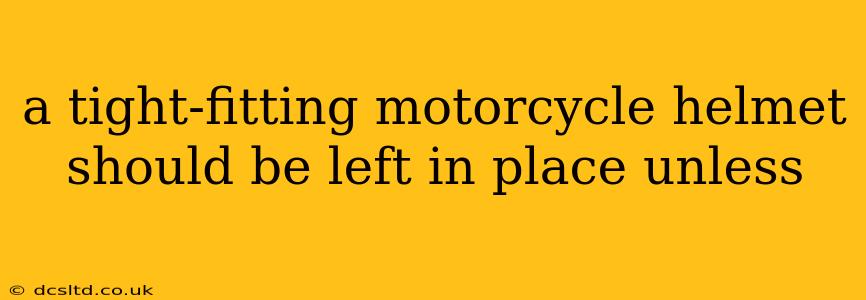A Tight-Fitting Motorcycle Helmet Should Be Left in Place Unless...
A motorcycle helmet is your first line of defense against serious injury in a crash. Its snug fit is crucial for optimal protection, but knowing when to remove it is just as important. Leaving a helmet on after an accident, especially a serious one, is generally advised unless specific circumstances necessitate removal. Let's explore the crucial considerations.
Why Should You Keep Your Helmet On After a Motorcycle Accident?
The primary reason to leave your helmet on is to prevent further injury to your neck and spine. Removing a helmet improperly can cause significant movement in the neck, potentially exacerbating existing injuries. Medical professionals are trained to carefully remove helmets without causing additional harm. They have the expertise and tools to assess the situation and handle the removal process safely.
When is Removing a Motorcycle Helmet Necessary?
While leaving your helmet on is generally recommended, there are specific situations where immediate removal may be necessary:
1. Difficulty Breathing:
Is it dangerous to leave a motorcycle helmet on if you can't breathe? Absolutely. If you are having trouble breathing, or if the helmet is obstructing your airway in any way, it must be removed immediately. Prioritizing your breathing takes precedence over the risk of further spinal injury. This takes precedence over any other concern. Bystanders should carefully assess the situation and if possible assist with removal while keeping the neck as stable as possible; however, professional emergency personnel should be called immediately.
2. Vomiting or Bleeding:
Should you remove a motorcycle helmet if someone is vomiting or bleeding? If a rider is vomiting or experiencing significant bleeding that could obstruct their airway, removing the helmet to clear the obstruction is justifiable. Again, this needs to be done carefully, preferably by trained professionals, to minimize further neck movement. The benefits of clearing an airway outweigh the risk of moving the neck.
3. Imminent Danger:
When should a motorcycle helmet be removed due to a dangerous situation? If the accident scene poses an imminent danger—for example, an uncontrolled fire or oncoming traffic—removing the helmet may be necessary to get the injured person to safety. However, this should be done with extreme caution and only if absolutely necessary, prioritizing the safe movement of the victim.
4. Severe Facial Injuries:
Is it necessary to remove a helmet in case of severe facial injuries? Severe facial injuries that obstruct breathing or impair the ability to assess the airway may necessitate helmet removal. Emergency personnel are trained to assess this and proceed cautiously. Once again, this is a critical situation where the immediate threat of facial injury takes priority.
Who Should Remove the Helmet?
Only trained emergency medical personnel should remove a motorcycle helmet after a motorcycle accident, unless it is absolutely necessary to save the injured person's life. They possess the expertise, equipment, and training to safely remove a helmet without causing additional damage. Improper removal can lead to serious, even life-threatening complications. Attempting to remove a helmet yourself could result in worsening pre-existing injuries, paralysis, or even death.
In Conclusion:
Leaving your motorcycle helmet in place after an accident is the safest course of action, unless you're facing a life-threatening situation where removing it is absolutely necessary for immediate survival. Always prioritize your safety and wait for trained medical professionals to assess and remove your helmet appropriately. Remember, your helmet is a vital piece of safety equipment, and even though it is tight-fitting, its continued presence can often be more beneficial than hasty removal.
